2013 VOLKSWAGEN TRANSPORTER engine
[x] Cancel search: enginePage 349 of 486
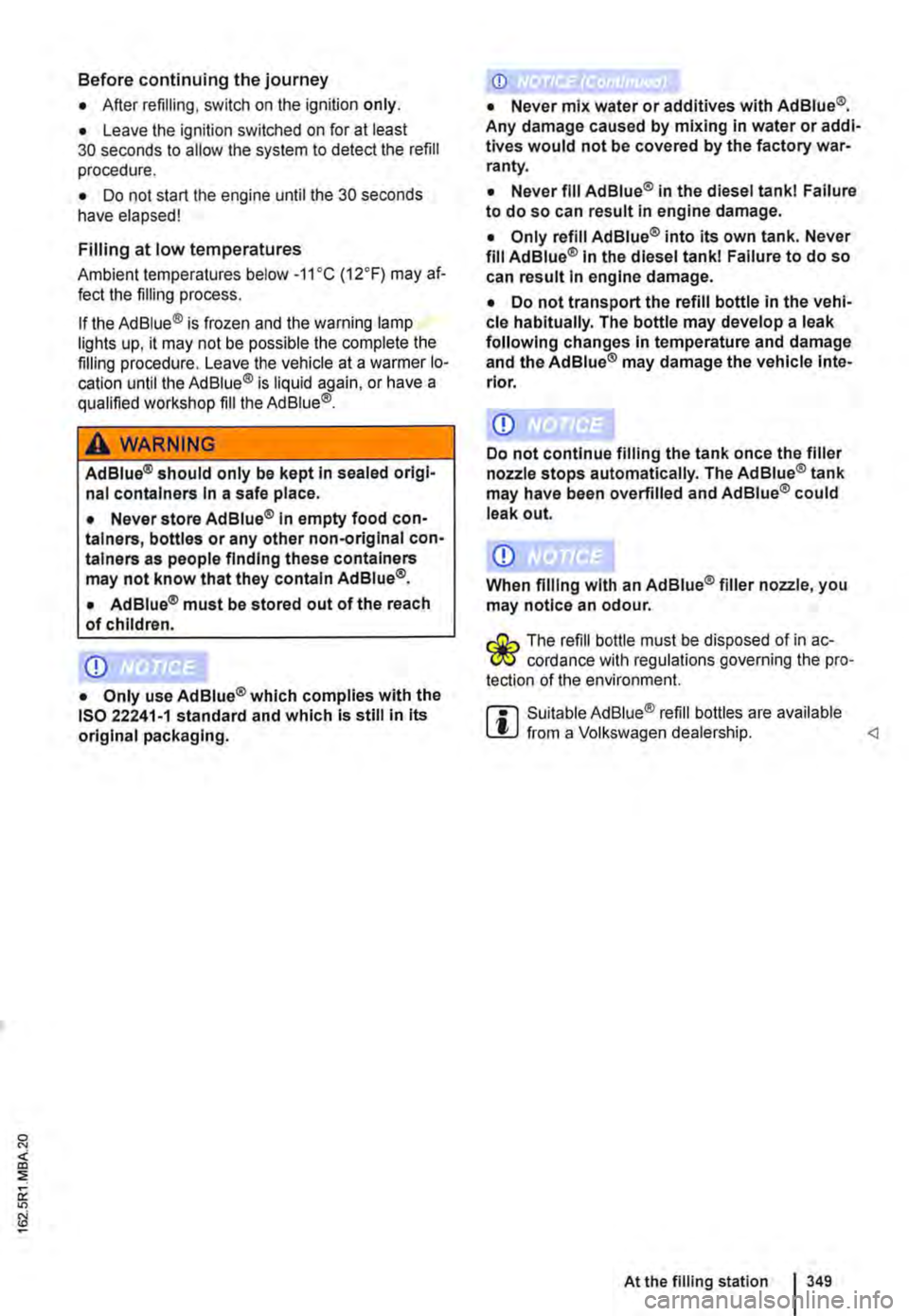
Before continuing the journey
• After refilling, switch on the ignition only.
• Leave the ignition switched on for at least 30 seconds to allow the system to detect the refill procedure.
• Do not start the engine until the 30 seconds have elapsed!
Filling at low temperatures
Ambient temperatures below -11 •c (12.F) may af-fect the filling process.
If the Ad Blue® is frozen and the warning lamp lights up, it may not be possible the complete the filling procedure. Leave the vehicle at a warmer lo-cation until the Ad Blue® is liquid again, or have a qualified workshop fill the Ad Blue®.
A WARNING
Ad Blue® should only be kept In sealed origi-nal containers In a safe place.
• Never store Ad Blue® In empty food con-tainers, bottles or any other non-original con-tainers as people finding these containers may not know that they contain Ad Blue®.
• Ad Blue® must be stored out of the reach of children.
CD
• Only use Ad Blue® which complies with the ISO 22241-1 standard and which Is still in its original packaging.
• Never fill AdBiue® In the diesel tank! Failure to do so can result In engine damage.
• Only refill Ad Blue® into its own tank. Never fill AdBiue® In the diesel tank! Failure to do so can result In engine damage.
• Do not transport the refill bottle in the vehi-cle habitually. The bottle may develop a leak following changes In temperature and damage and the Ad Blue® may damage the vehicle Inte-rior.
CD
Do not continue filling the tank once the filler nozzle stops automatically. The Ad Blue® tank may have been overfilled and AdBiue® could leak out.
CD
When filling with an Ad Blue® filler nozzle, you may notice an odour.
The refill bottle must be disposed of in ac-"'7!1S cordance with regulations governing the pro-tection of the environment.
r::l Suitable Ad Blue® refill bottles are available L!J from a Volkswagen dealership.
Page 350 of 486
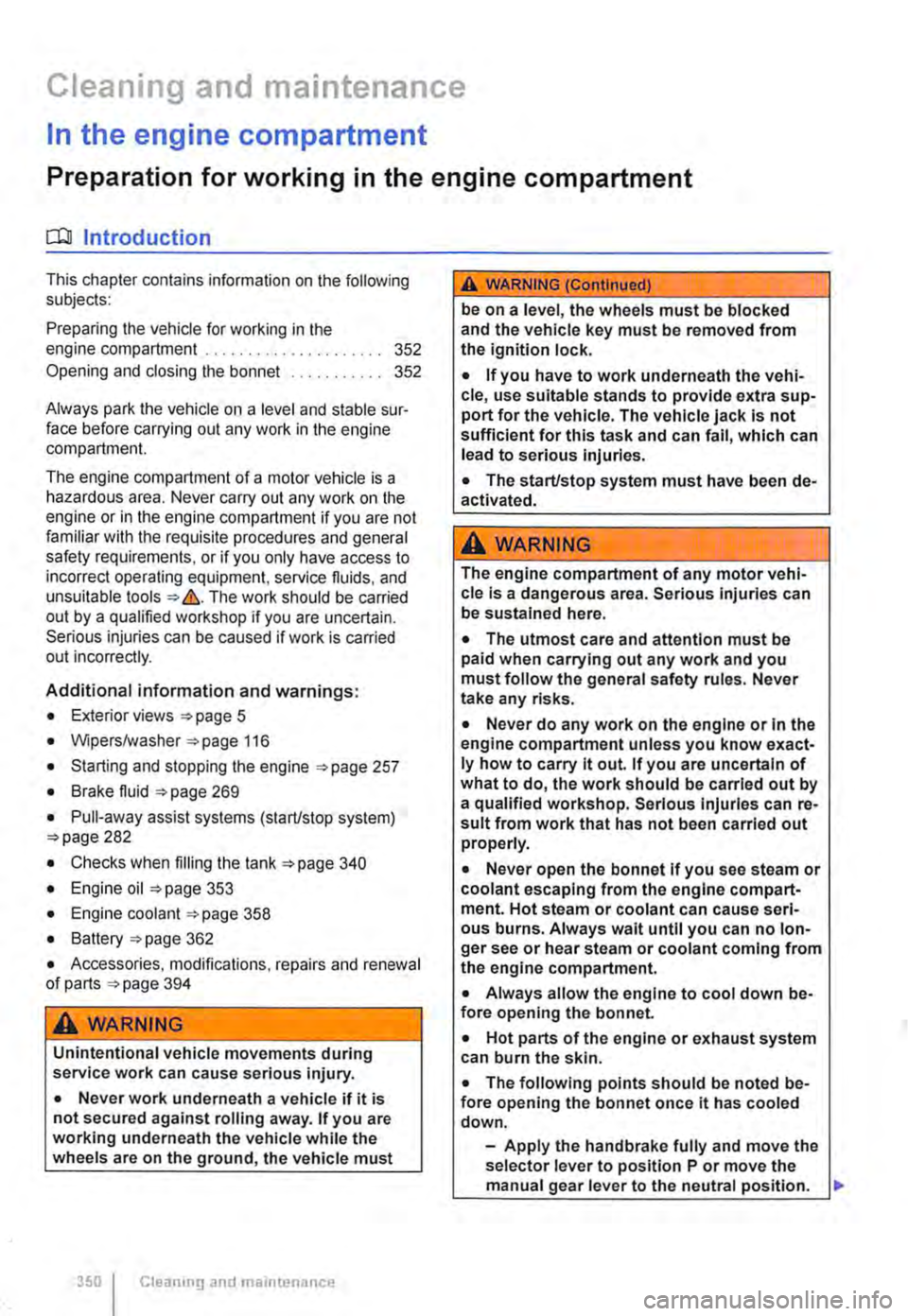
Cleaning and maintenance
In the engine compartment
Preparation for working in the engine compartment
ClJ Introduction
This chapter contains information on the following subjects:
Preparing the vehicle for working in the engine compartment . . . . . . . . . . . . . . . . . 352 Opening and closing the bonnet 352
Always park the vehicle on a level and stable sur-face before carrying out any work in the engine compartment.
The engine compartment of a motor vehicle is a hazardous area. Never carry out any work on the engine or in the engine compartment if you are not familiar with the requisite procedures and general safety requirements, or if you only have access to incorrect operating equipment, service fluids, and unsuitable tools &. The work should be carried out by a qualified workshop if you are uncertain. Serious injuries can be caused if work is carried out incorrectly.
Additional information and warnings:
• Exterior views 5
• Wipers/washer 116
• Starting and stopping the engine 257
• Brake fluid 269
• Pull-away assist systems (starUstop system) 282
• Checks when filling the tank 340
• Engine oil 353
• Engine coolant 358
• Battery page 362
• Accessories, modifications, repairs and renewal of parts 394
A wARNING
Unintentional vehicle movements during service work can cause serious injury.
• Never work underneath a vehicle if it is not secured against rolling away. If you are working underneath the vehicle while the wheels are on the ground, the vehicle must
350 I Cleanmg and maintenance
A WARNING (Continued)
be on a level, the wheels must be blocked and the vehicle key must be removed from the ignition lock.
• If you have to work underneath the vehi-cle, use suitable stands to provide extra sup-port for the vehicle. The vehicle jack is not sufficient for this task and can fail, which can lead to serious injuries.
• The start/stop system must have been de-activated.
A WARNING
The engine compartment of any motor vehi-cle is a dangerous area. Serious injuries can be sustained here.
• The utmost care and attention must be paid when carrying out any work and you must follow the general safety rules. Never take any risks.
• Never do any work on the engine or in the engine compartment unless you know exact-ly how to carry it out. If you are uncertain of what to do, the work should be carried out by a qualified workshop. Serious Injuries can re-sult from work that has not been carried out properly.
• Never open the bonnet if you see steam or coolant escaping from the engine compart-ment. Hot steam or coolant can cause seri-ous burns. Always wait until you can no lon-ger see or hear steam or coolant coming from the engine compartment.
• Always allow the engine to cool down be-fore opening the bonnet.
• Hot parts of the engine or exhaust system can burn the skin.
• The following points should be noted be-fore opening the bonnet once it has cooled down.
-Apply the handbrake fully and move the selector lever to position P or move the manual gear lever to the neutral position. .,..
Page 351 of 486
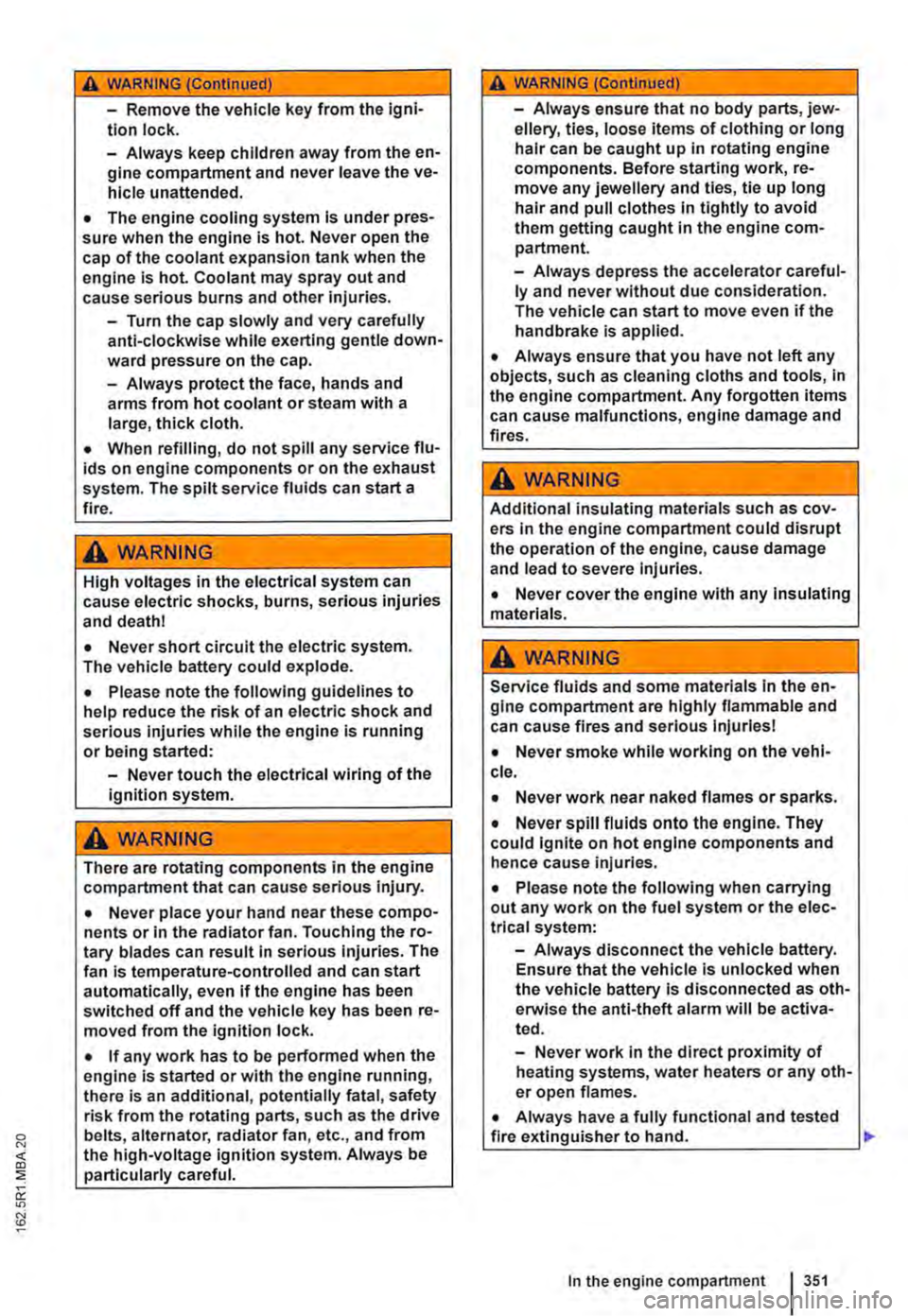
A WARNING (Continued)
-Remove the vehicle key from the igni-tion lock.
-Always keep children away from the en-gine compartment and never leave the ve-hicle unattended.
• The engine cooling system Is under pres-sure when the engine Is hot. Never open the cap of the coolant expansion tank when the engine Is hot. Coolant may spray out and cause serious burns and other Injuries.
-Turn the cap slowly and very carefully anti-clockwise while exerting gentle down-ward pressure on the cap.
-Always protect the face, hands and arms from hot coolant or steam with a large, thick cloth.
• When refilling, do not spill any service flu-ids on engine components or on the exhaust system. The spilt service fluids can start a fire.
A WARNING
High voltages in the electrical system can cause electric shocks, burns, serious injuries and death!
• Never short circuit the electric system. The vehicle battery could explode.
• Please note the following guidelines to help reduce the risk of an electric shock and serious Injuries while the engine is running or being started:
-Never touch the electrical wiring of the Ignition system.
A WARNING
There are rotating components in the engine compartment that can cause serious injury.
• Never place your hand near these compo-nents or In the radiator fan. Touching the ro-tary blades can result in serious injuries. The fan Is temperature-controlled and can start automatically, even if the engine has been switched off and the vehicle key has been re-moved from the ignition lock.
• If any work has to be performed when the engine Is started or with the engine running, there is an additional, potentially fatal, safety risk from the rotating parts, such as the drive belts, alternator, radiator fan, etc., and from the high-voltage ignition system. Always be particularly careful.
A WARNING (Continued)
-Always ensure that no body parts, jew-ellery, ties, loose items of clothing or long hair can be caught up in rotating engine components. Before starting work, re-move any jewellery and ties, tie up long hair and pull clothes In tightly to avoid them getting caught In the engine com-partment.
-Always depress the accelerator careful-ly and never without due consideration. The vehicle can start to move even if the handbrake is applied.
• Always ensure that you have not left any objects, such as cleaning cloths and tools, in the engine compartment. Any forgotten items can cause malfunctions, engine damage and fires.
A WARNING
Additional insulating materials such as cov-ers in the engine compartment could disrupt the operation of the engine, cause damage and lead to severe Injuries.
• Never cover the engine with any Insulating materials.
A WARNING
Service fluids and some materials In the en-glne compartment are highly flammable and can cause fires and serious Injuries!
• Never smoke while working on the vehl-cl e.
• Never work near naked flames or sparks .
• Never spill fluids onto the engine. They could Ignite on hot engine components and hence cause injuries.
• Please note the following when carrying out any work on the fuel system or the elec-trlcal system:
-Always disconnect the vehicle battery. Ensure that the vehicle Is unlocked when the vehicle battery Is disconnected as oth-erwlse the anti-theft alarm will be activa-ted.
-Never work in the direct proximity of heating systems, water heaters or any oth-er open flames.
• Always have a fully functional and tested fire extinguisher to hand.
In the engine compartment I 351
...
Page 352 of 486
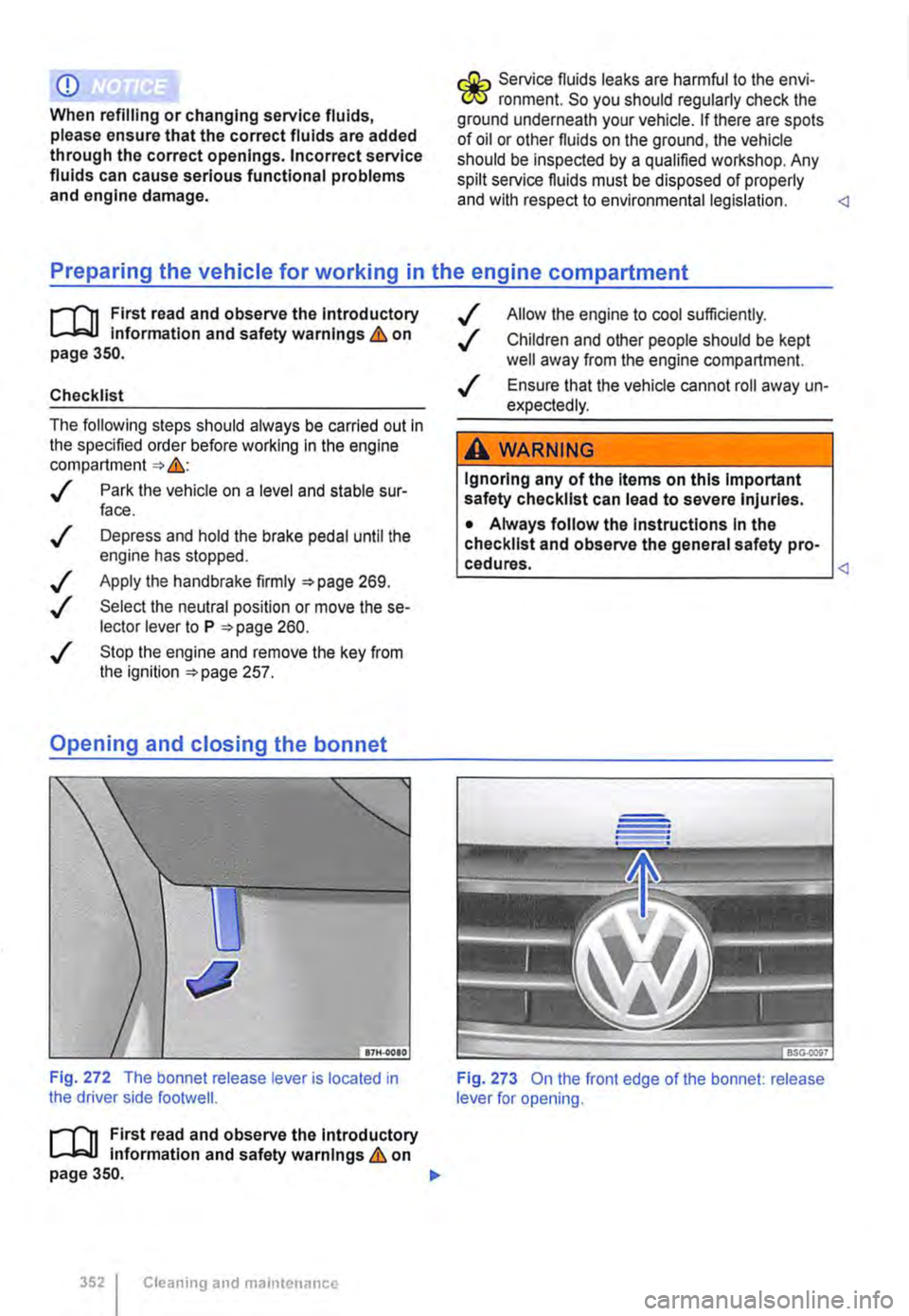
CD
When refilling or changing service fluids, please ensure that the correct fluids are added through the correct openings. Incorrect service fluids can cause serious functional problems and engine damage.
r:(ib Service fluids leaks are harmful to the envi-f!f:J ronment. So you should regularly check the ground underneath your vehicle. If there are spots of oil or other fluids on the ground, the vehicle should be inspected by a qualified workshop. Any spilt service fluids must be disposed of properly and with respect to environmental legislation.
1"1'11 First read and observe the Introductory L-.J,::,jJ Information and safety warnings & on page 350.
Checklist
The following steps should always be carried out in the specified order before working In the engine compartment =:-&,:
..( Park the vehicle on a level and stable sur-face.
..! Depress and hold the brake pedal until the engine has stopped.
Apply the handbrake firmly ::-page 269.
Select the neutral position or move the se-lector lever toP =:-page 260 .
..( Stop the engine and remove the key from the ignition =:-page 257.
Opening and closing the bonnet
Fig. 272 The bonnet release lever is located in the driver side footwell.
1"1'11 First read and observe the introductory L-.J,::,,J Information and safety warnings & on page 350.
352 I Cleaning and maintenance
Allow the engine to cool sufficiently.
Children and other people should be kept well away from the engine compartment.
Ensure that the vehicle cannot roll away un-expectedly.
A WARNING
Ignoring any of the Items on this Important safety checklist can lead to severe Injuries.
• Always follow the Instructions In the checklist and observe the general safety pro-cedures.
Page 353 of 486
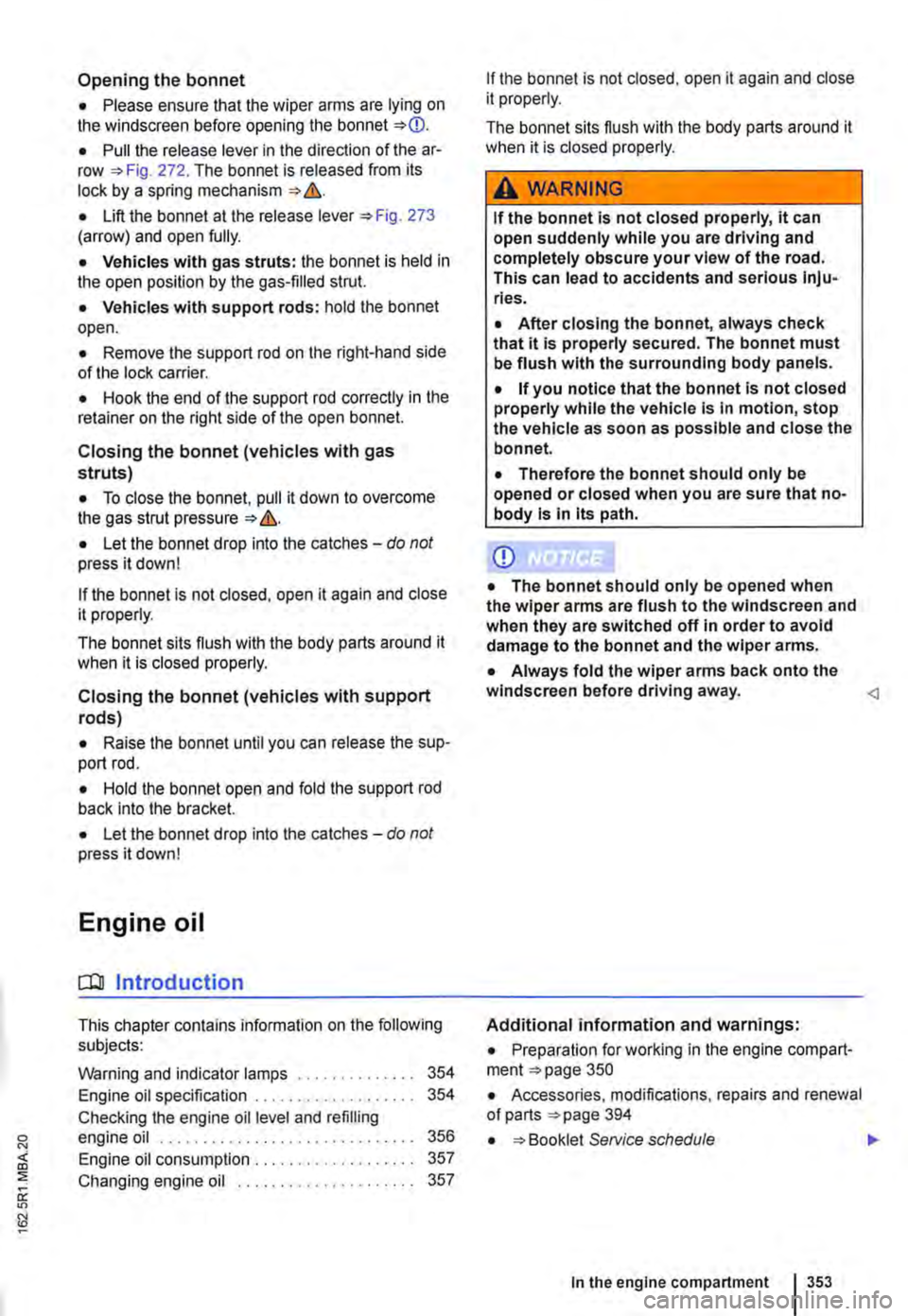
Opening the bonnet
• Please ensure that the wiper arms are lying on the windscreen before opening the bonnet =:.CD.
• Pull the release lever in the direction of the ar-row =:.Fig. 272. The bonnet is released from its lock by a spring mechanism =:. &.
• Lift the bonnet at the release lever =:.Fig. 273 (arrow) and open fully.
• Vehicles with gas struts: the bonnet is held in the open position by the gas-filled strut.
• Vehicles with support rods: hold the bonnet open.
• Remove the support rod on the right-hand side of the lock carrier.
• Hook the end of the support rod correctly in the retainer on the right side of the open bonnet.
Closing the bonnet (vehicles with gas struts)
• To close the bonnet, pull it down to overcome the gas strut pressure =:. &.
• Let the bonnet drop into the catches-do not press it down!
If the bonnet is not closed, open it again and close it properly.
The bonnet sits flush with the body parts around it when it is closed properly.
Closing the bonnet (vehicles with support rods)
• Raise the bonnet until you can release the sup-port rod.
• Hold the bonnet open and fold the support rod back into the bracket.
• Let the bonnet drop into the catches -do not press it down!
Engine oil
CO Introduction
This chapter contains information on the following subjects:
Warning and indicator lamps 354 Engine oil specification . . . . 354 Checking the engine oil level and refilling engine oil . . . . . . . . . . . . . . 356 Engine oil consumption . . . . . . . . . . . . . . . . . . . 357
Changing engine oil . . . . . . . . . . . . . . . . . . . . . 357
If the bonnet is not closed, open it again and close it properly.
The bonnet sits flush with the body parts around it when it is closed properly.
A WARNING
If the bonnet is not closed properly, it can open suddenly while you are driving and completely obscure your view of the road. This can lead to accidents and serious Inju-ries.
• After closing the bonnet, always check that it is properly secured. The bonnet must be flush with the surrounding body panels.
• If you notice that the bonnet is not closed properly while the vehicle is in motion, stop the vehicle as soon as possible and close the bonnet.
• Therefore the bonnet should only be opened or closed when you are sure that no-body is in its path.
CD
• The bonnet should only be opened when the wiper arms are flush to the windscreen and when they are switched off in order to avoid damage to the bonnet and the wiper arms.
• Always fold the wiper arms back onto the windscreen before driving away.
• Preparation for working in the engine compart-ment =:.page 350
• Accessories, modifications, repairs and renewal of parts =:.page 394
• =:. Booklet SeNice schedule ._
In the engine compartment 1353
Page 354 of 486

A WARNING
Incorrect handling of engine oil can cause se-rious burns and other Injuries.
• Always wear eye protection when han-dling engine oil.
• Engine oil is toxic and must be stored out of the reach of children.
• Engine oil must be kept in the closed orig-inal container. This also applies to used oil until it is disposed of.
• Never use empty food containers, bottles or other containers to store engine oil as oth-er people may then drink the engine oil.
Warning and indicator lamps
A WARNING (Continued)
• Regular contact with engine oil can dam-age the skin. Skin that has been in contact with engine oil should be washed thoroughly with water and soap.
• Engine oil becomes extremely hot when the engine is running and can scald skin se-verely. Always allow the engine to cool down.
Leaking or spilt engine oil can pollute the en-(!Jtf vironment. Spilt service fluids must be collec-ted then disposed of properly and in an environ-mentally responsible way.
Lit up Possible cause
Engine oil level is too low. -
Flashes Possible cause
c:e:r. Engine oil pressure is too low.
r... Fault in the engine oil system.
A WARNING
Failure to observe illuminated warning lamps and text messages can lead to your vehicle breaking down in traffic, and can cause acci-dent and serious injury.
• Never ignore any illuminated warning lamps or text messages.
Engine oil specification
rT'n First read and observe the introductory L-J,::.U information and safety warnings & on page 353.
354 I Cleaning and maintenance
Solution
Switch off the engine. Check the engine oil level "'Page 356.
Solution
t Do not drive on I Switch off the engine. Check the engine oillev-el. • Do not drive on or remain at idling speed if the warning lamp is flashing even if the engine oil level is correct. The engine could otherwise be damaged. Seek expert assistance.
Go to a qualified workshop. The engine oil sen-sor should be checked.
A WARNING (Continued)
• Stop the vehicle as soon as possible and when safe to do so.
Q)
Failure to observe illuminated Indicator lamps and text messages can lead to your vehicle be-ing damaged.
Page 355 of 486
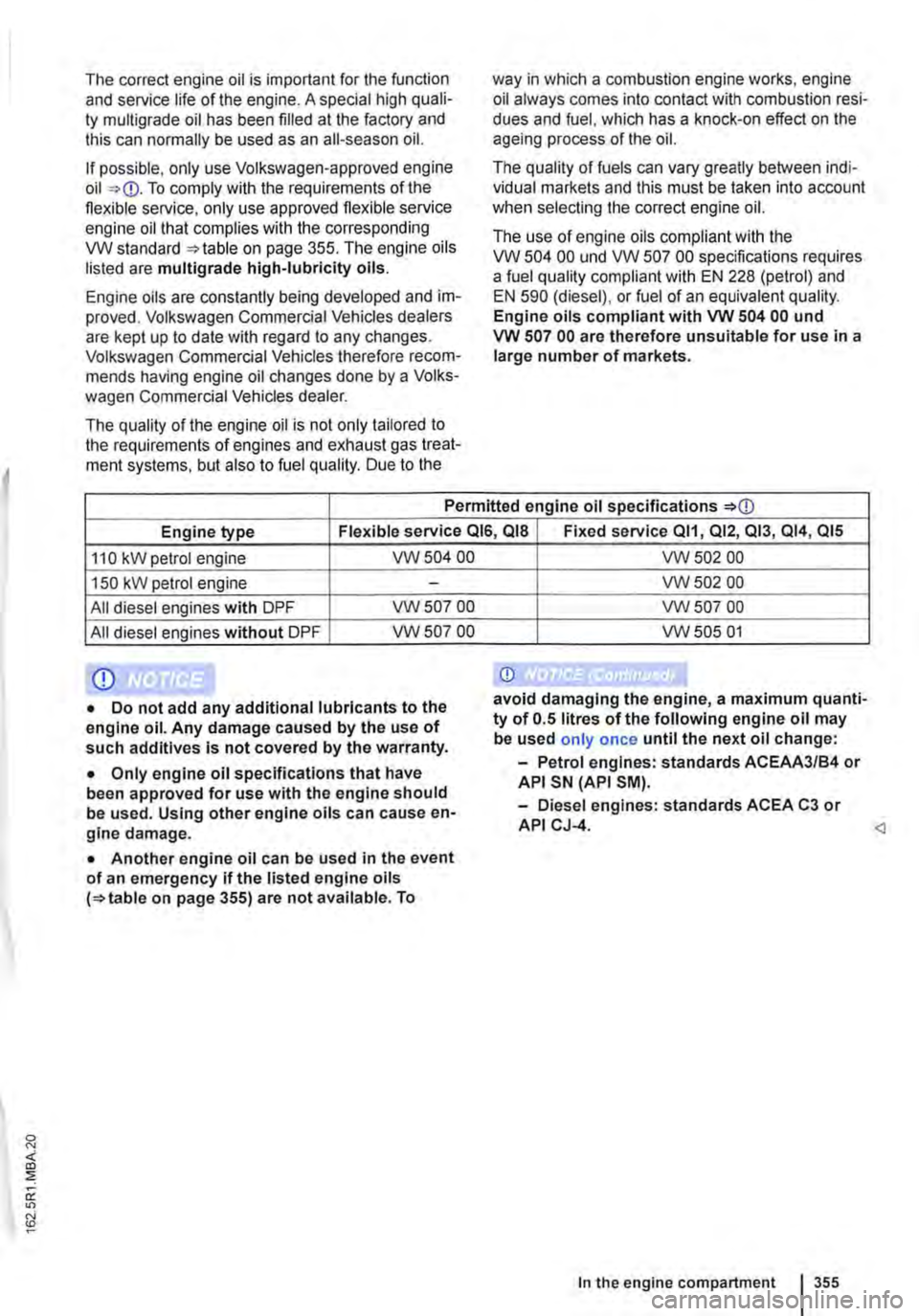
The correct engine oil is important for the function and service life of the engine. A special high quali-ty multigrade oil has been filled at the factory and this can normally be used as an all-season oil.
If possible, only use Volkswagen-approved engine oil =>CD. To comply with the requirements of the flexible service, only use approved flexible service engine oil that complies with the corresponding VW standard =>table on page 355. The engine oils listed are multigrade high-lubricity oils.
Engine oils are constantly being developed and im-proved. Volkswagen Commercial Vehicles dealers are kept up to date with regard to any changes. Volkswagen Commercial Vehicles therefore recom-mends having engine oil changes done by a Volks-wagen Commercial Vehicles dealer.
The quality of the engine oil is not only tailored to the requirements of engines and exhaust gas treat-ment systems, but also to fuel quality. Due to the
way in which a combustion engine works, engine oil always comes into contact with combustion resi-dues and fuel, which has a knock-on effect on the ageing process of the oil.
The quality of fuels can vary greatly between indi-vidual markets and this must be taken into account when selecting the correct engine oil.
The use of engine oils compliant with the VW 504 00 und VW 507 00 specifications requires a fuel quality compliant with EN 228 (petrol) and EN 590 (diesel), or fuel of an equivalent quality. Engine oils compliant with VW 504 00 und VW 507 00 are therefore unsuitable for use in a large number of markets.
Permitted engine oil specifications =>CD
Engine type Flexible service QIS, QIS Fixed service Ql1, Ql2, Q13, Ql4, Ql5
110 kW petrol engine VW504 00
150 kW petrol engine -
All diesel engines with DPF VW507 00
All diesel engines without DPF VW507 00
CD
• Do not add any additional lubricants to the engine oil. Any damage caused by the use of such additives is not covered by the warranty.
• Only engine oil specifications that have been approved for use with the engine should be used. Using other engine oils can cause en-gine damage.
• Another engine oil can be used in the event of an emergency if the listed engine oils (=>table on page 355) are not available. To
vw 502 00
VW502 00
VW507 00
VW505 01
CD
avoid damaging the engine, a maximum quanti-ty of 0.5 litres of the following engine oil may be used only once until the next oil change:
-Petrol engines: standards ACEAA3/B4 or API SN (API SM).
-Diesel engines: standards ACEA C3 or APICJ4.
In the engine compartment 1355
Page 356 of 486
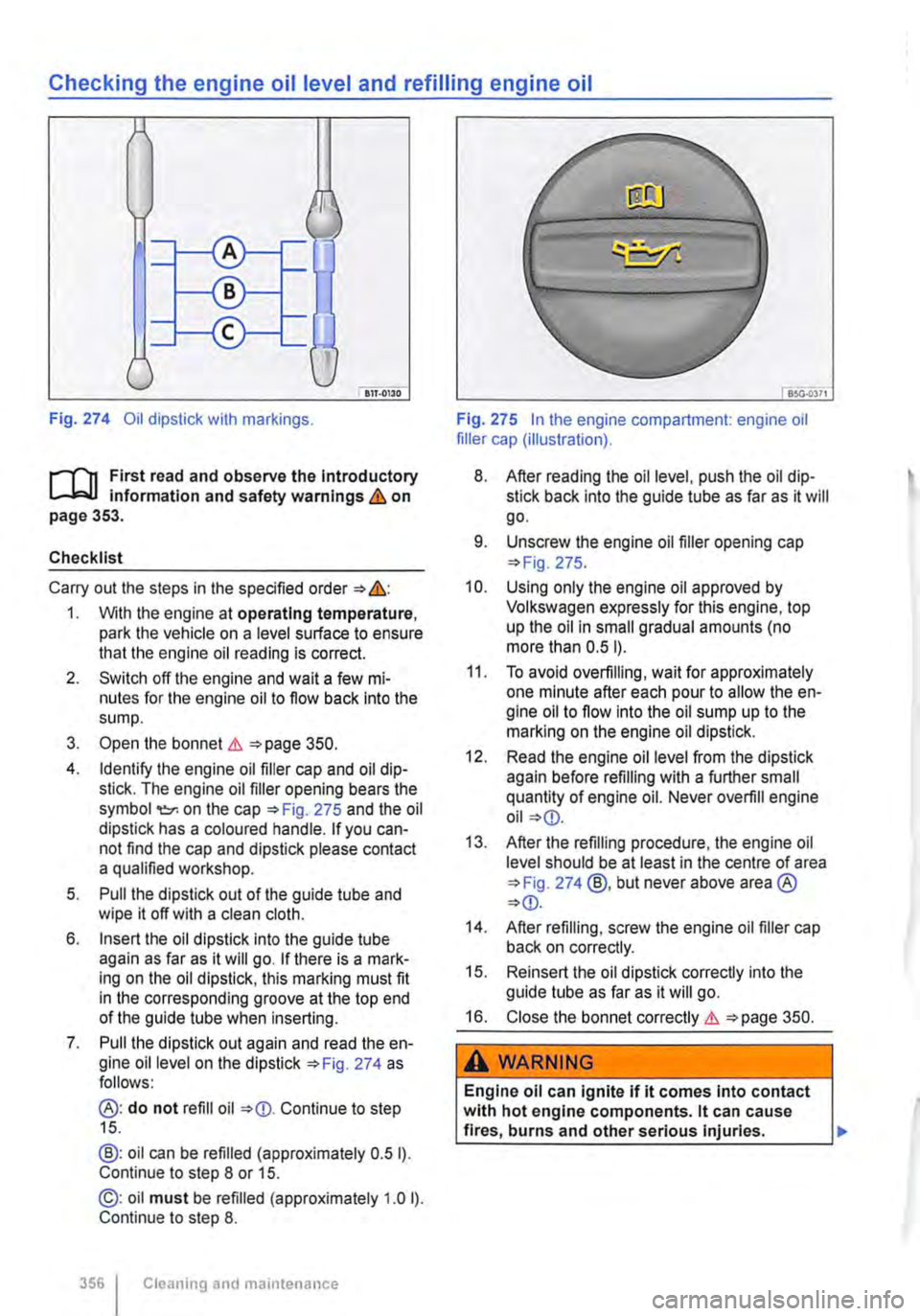
Checking the engine oil level and refilling engine oil
Fig. 274 Oil dipstick with markings.
r-111 First read and observe the Introductory L-W! information and safety warnings & on page 353.
Checklist
Carry out the steps in the specified order &:
1. With the engine at operating temperature, park the vehicle on a level surface to ensure that the engine oil reading is correct.
2. Switch off the engine and wait a few mi-nutes for the engine oil to flow back into the sump.
3. Open the bonnet&. 350.
4. Identify the engine oil filler cap and oil dip-stick. The engine oil filler opening bears the symbol 'l!:r. on the cap 275 and the oil dipstick has a coloured handle. If you can-not find the cap and dipstick please contact a qualified workshop.
5. Pull the dipstick out of the guide tube and wipe it off with a clean cloth.
6. Insert the oil dipstick into the guide tube again as far as it will go. If there is a mark-ing on the oil dipstick, this marking must fit in the corresponding groove at the top end of the guide tube when inserting.
7. Pull the dipstick out again and read the en-gine oil level on the dipstick 274 as follows:
@: do not refill oil Continue to step 15.
@: oil can be refilled (approximately 0.5 1). Continue to step 8 or 15.
©: oil must be refilled (approximately 1.0 1). Continue to step 8.
356 I Cleaning and maintenance
Fig. 275 in the engine compartment: engine oil filler cap (illustration).
8. After reading the oil level, push the oil dip-stick back into the guide tube as far as it will go.
9. Unscrew the engine oil filler opening cap =>Fig. 275.
1 0. Using only the engine oil approved by Volkswagen expressly for this engine, top up the oil in small gradual amounts (no more than 0.5 1).
11. To avoid overfilling, wait for approximately one minute after each pour to allow the en-gine oil to flow into the oil sump up to the marking on the engine oil dipstick.
12. Read the engine oil level from the dipstick again before refilling with a further small quantity of engine oil. Never overfill engine oil
13. After the refilling procedure, the engine oil level should be at least in the centre of area =>Fig. 274 @,but never above area®
14. After refilling, screw the engine oil filler cap back on correctly.
15. Re insert the oil dipstick correctly into the guide tube as far as it will go.
16. Close the bonnet correctly & 350.
A WARNING
Engine oil can Ignite if it comes into contact with hot engine components. lt can cause fires, burns and other serious Injuries.